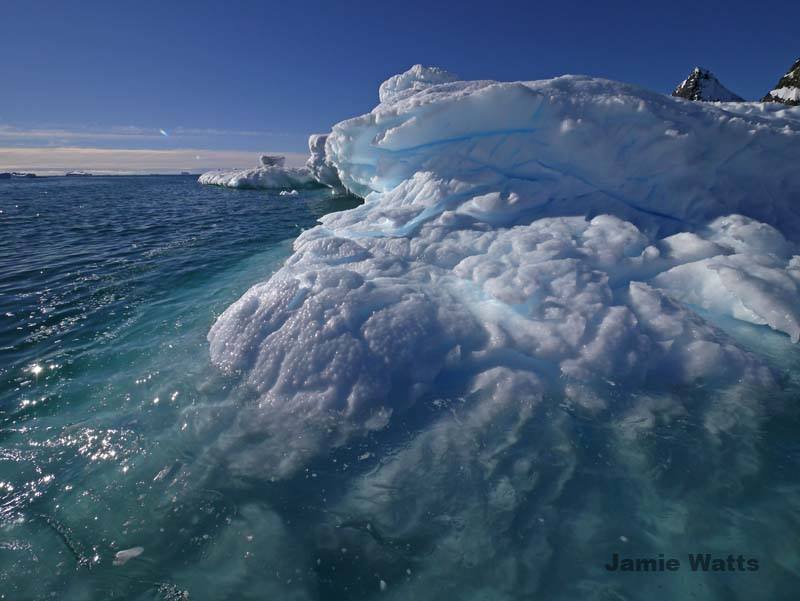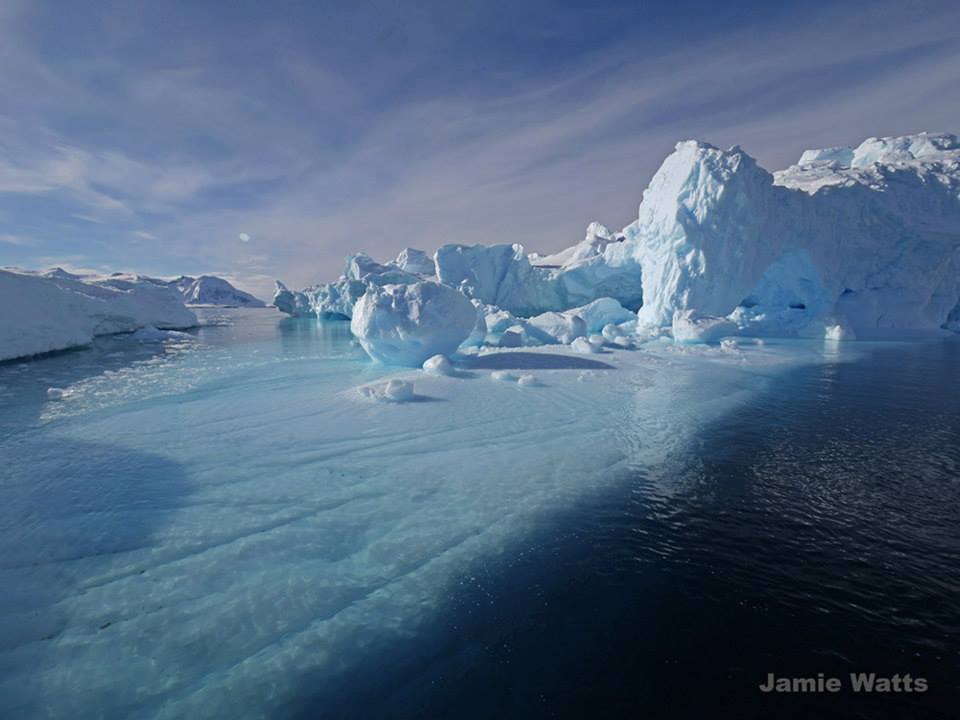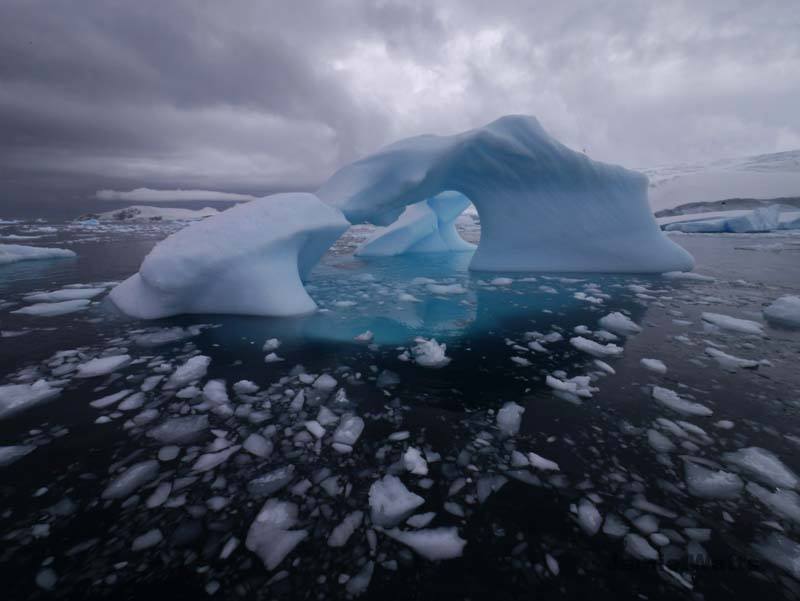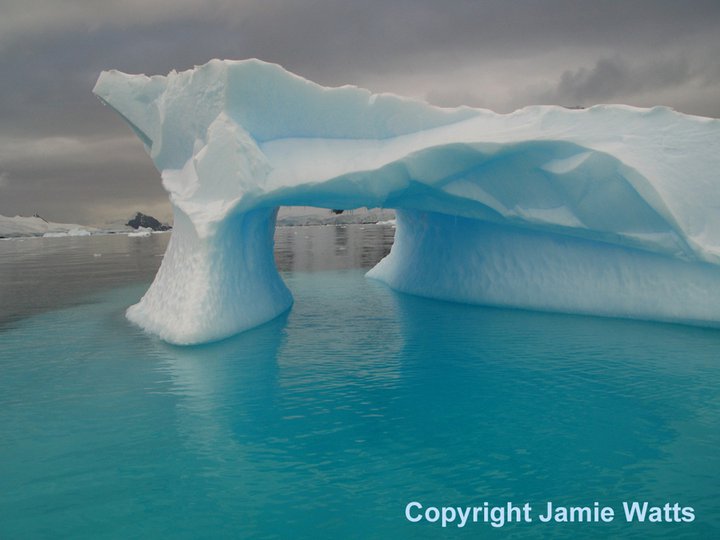News
Whales in the Antarctic
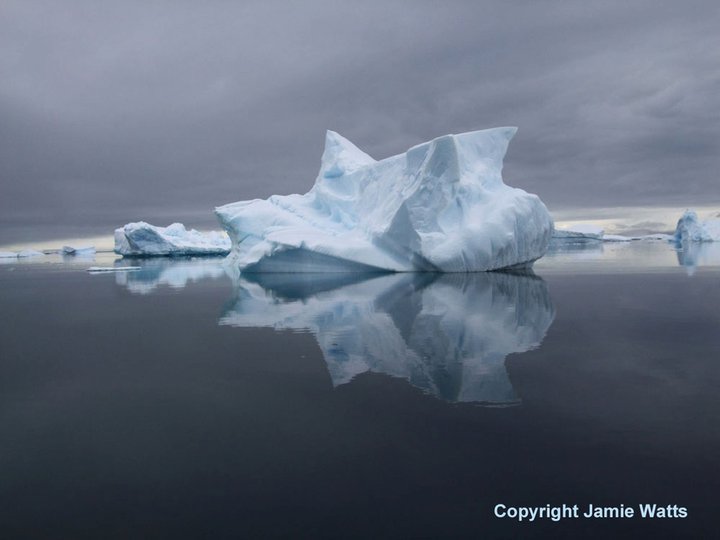
I’ve been coming down to the Antarctic Peninsula nine long summers now, and every year the humpbacks become more conspicuous, more numerous and more interactive. It’s a wonderful thing. Seven per cent population growth a year, researchers are estimating – as fast as they can possibly reproduce. Seven per cent is a magic number – it means doubling in a decade. By somewhere around the mid 2030s they should reach their pre-whaling levels.
We see minkes, mostly in amongst the loose brash, and we often see fin whales, generally out in the Drake or the open Scotia Sea. Very, very rarely we’ll see one of the giant blues; the Antarctic blue, the biggest subspecies of the biggest animal that ever lived – also the subspecies hit hardest by the whalers. But even with them there are positive signs; this year nine blues were seen together off South Georgia.
But the humpbacks – they move where we tourist ships move, outside the thickest ice but in amongst the islands. They don’t slice past us at speed like the others, but linger, stick around, even show curiosity for our Zodiacs and their inhabitants. They are the most playful, the most agile and athletic whale, the greatest migrator and the ones we know and love best.
Cierva Cove is close to where the Antarctic continent was first landed, 195 years ago. A stunning bay, boxed in somewhat by a couple of islands, with a magnificent glacier tumbling down into it from the spine of the Antarctic Peninsula beyond. It catches quite a few of the icebergs passing north from the Gerlache strait, and the back of the bay is impenetrable to our zodiacs much of the time with thick brash and massive bergs. It also catches nice pockets of krill, and this is why on this particular late February morning dozens of humpback whales were working the bay.
We started spotted them way out from our drifting position as soon as we had light – threes and fours, lunging at the surface. Further in we passed several groups close to the ship, and as we slowed down to lower Zodiacs they even started to approach more closely. They weren’t even slightly interested in the ship, I think, they were just working their way through the krill and it happened to bring them in our direction.
First whale up close and personal from the Zodiac was a youngster, perhaps eight or nine metres long and about ten tonnes. It’s a young population and many of these animals are just a few years old. He was energetic, multiple lunges near our little boat, and curious – he spy-hopped us. But he was also somewhat inefficient in his foraging. The faster, sleeker whales work alone and do fast lunges, but that’s not what works best for humpbacks. He was doing short, fast gulps, not opening his throat widely, but more importantly he wasn’t doing anything to herd the krill. Maybe a phone-booth’s volume of water each gulp, but probably only a kilo or so of krill with each mouthful.
The Antarctic krill is earth’s greatest protein and oil source, attracting the largest gatherings of marine mammals and birds on earth. But the average density even here is pretty low – to feed effectively you not only need to find the densest patches of krill but you need to gather them efficiently. Before whaling, the great whales had become ecologically a force to be reckoned with – the greatest consumers of food of any mammal group on the planet (unprecedented for carnivores) until the rise of humans. They were masters of the densest ocean food web of all, due to their stupendous foraging arsenal.
The next humpbacks were a bit more onto it. Three whales working together, they were working spirals, and at least one of them was bubble-netting. Humpback arms are the biggest limbs on earth – over five metres long in large animals. They look odd and lumpy, but it turns out the knobbles and patches of barnacles break up water turbulence, and these long wing-like arms are superbly efficient hydrofoils. Not only do they provide lift – these animals literally fly through the water on the longest migrations of any whale – but they can also bend and twist to give humpbacks incredible high-speed twists and turns that no other whale can perform.
Combined with their rather muscular build and a level of hunting coordination that has never been seen in other whales, this makes for an impressive krill-gathering ability. The larger of these three whales was bubble-netting; swimming below and around the edge of the krill swarm letting out a curtain of bubbles, which herds the krill towards the middle in a tight cluster. The other whales swam around the edge, waving their tails inwards. Then one at a time they would lunge in towards the middle of the prey cluster, taking a large gulp.
Another group appeared, closing in and before long was working alongside this trio – the two groups even looked to be helping each other out – packing their two krill patches tight right up against each other. The new trio included two larger animals – thirteen metres or more and perhaps thirty tonnes apiece, and both were bubble-netting. I have seen dozens of bubble-nets and they always spiral inwards to the right. Humpback whales, like Derek Zoolander, are not ambi-turners, apparently.
A couple of times the bubbles started to surface just ahead or just to the side of the Zodiac. I wasn’t concerned – I have never known a whale to be anything other than superbly aware, sensitive to and more than able to avoid boats or swimmers.
It seems that the humpbacks improve the art and technique of bubble-netting as they mature. It requires coordination and communication, as well as rather an impressive use of the ever-tightening turns afforded by those huge arms. We have no idea how they coordinate, or indeed how they are aware of or find the krill in the water, but the concentrations of krill they absolutely depend on – kilogrammes per cubic metre – are rather high. The two larger whales of the joining trio did a classic, elegant double spiral of bubble nets. The first whale started a ring about fifteen metres across, then fifteen seconds later a second set began to appear across the other side, both spiralling in together in a beautiful fractal symmetry. A pause and then a lunge – all three whales at 45 degrees upwards through the middle of the concentrated krill patch.
The sheer physics of the lunge itself is pretty impressive. Off Alaska where the humpbacks hunt faster-moving prey the lunges are fast, vertical and vast. Down here, the krill-eaters are somewhat more sedate, but still impressive. The smaller, younger animals seem to have less distendable throats and do shorter, almost horizontal surface lunges, sometimes flopping over on one side. I even saw a young whale last year porpoising over the top and opening its mouth as it came down on top of the krill patch.
The bigger, older whales seem to mature their abilities and perhaps become more physically flexible in the throat. They lunge straight upwards after a tight turn at the end of the bubble-net. They accelerate then snap their mouths open wide – up to about right angles – at the last couple of seconds just before they hit the surface. The articulation of the jaw opens out on elastic tendons, and the front joint of the jaw is similarly flexible so that the arch of the jaw opens outwards to widen the scoop. The forces are enormous. The grooved throat balloons out to about the size of a small garage to take in up to twenty tonnes of water in a large adult, the sofa-sized tongue turned inside out by the force of the sudden opening of the parachute-like gape. The mouth then snaps shut, sealing quickly at the front of the lips, squeezing out tonne after tonne of water through the filter of the baleen plates hanging from the sides of the top lip as it zips shut from the tip of the snout backwards on either side. Then the throat squeezes, water gushing back through the baleen and out of the downturned corners of the mouth over the eyes. The sides of the jaw and the muscular throat, deformed by the pressure of the lunge, slowly pull back into place.
An Antarctic humpback might gather tens of kilos with each gulp, and after a good morning of feeding have a tonne of krill in their stomach. Only the fin and blue whales, with their even larger gapes and faster open-water lunges can gather more. The humpbacks gorge themselves, defecating as they are feeding to make space to squeeze in more krill, the big ones gaining ten to fifteen tonnes in a season. The largest get to fifty tonnes or more, as big as the largest dinosaurs. The faeces seeds the ocean with iron – and until 75 years ago gave the Southern Ocean an iron boost that fertilized the seas and drove up plankton productivity as well as natural carbon sequestration. And they’re coming back.
In every direction, groups of three to four whales moved around, sometimes coming together as clusters, sometimes spy-hopping close to our boats. We left them for a while to play in the brash and look at some icebergs and a dozing leopard seal, but on the way back to the ship came across more groups. We had to get back, the ship had to leave, to head north towards Elephant Island then South Georgia.
Oh all right, then, one more group of whales….
Visit Jamie’s website for all his latest news and blogs: www.jamiewatts.co.uk
Jamie’s blog was provided by Oonasdivers.
Gear News
Scubapro Free Octopus Promotion 2024

Free Octopus with every purchase of a SCUBAPRO regulator system
Just in time for the spring season, divers can save money with the FREE OCTOPUS SPRING PROMOTION! Until July 31st SCUBAPRO offers an Octopus for free
with every purchase of a regulator system!
Get a free S270 OCTOPUS with purchase of these combinations:
MK25 EVO or MK19 EVO with A700
MK25 EVO or MK19 EVO with S620Ti
MK25 EVO or MK19 EVO with D420
MK25 EVO Din mit S620Ti-X
Get a free R105 OCTOPUS with purchase of the following combinations:
MK25 EVO or MK19 EVO with G260
MK25 EVO or MK17 EVO with S600
SCUBAPRO offers a 30-year first owner warranty on all regulators, with a revision period of two years or 100 dives. All SCUBAPRO regulators are of course certified according to the new European test standard EN250-2014.
Available at participating SCUBAPRO dealers. Promotion may not be available in all regions. Find an authorized SCUBAPRO Dealer at scubapro.com.
More information available on www.scubapro.com.
Blogs
Northern Red Sea Reefs and Wrecks Trip Report, Part 3: The Mighty Thistlegorm

Jake Davies boards Ghazala Explorer for an unforgettable Red Sea diving experience…
Overnight, the wind picked up, making the planned morning dive a bit bumpy on the Zodiacs to the drop point on Thomas Reef. There, we would dive along the reef before descending through the canyon and then passing under the arch before ascending the wall with a gentle drift. The site provided great encounters with more pelagic species, including shoals of large barracuda, tuna, and bigeye trevally.
Once back on the boat, it was time to get everything tied down again as we would head back south. This time, with the wind behind us, heading to Ras Mohammed to dive Jackfish Alley for another great gentle drift wall dive before then heading up the coast towards the Gulf of Suez to moor up at the wreck of the Thistlegorm. This being the highlight wreck dive of the trip and for many onboard, including myself, it was the first time diving this iconic wreck. I had heard so much about the wreck from friends, and globally, this is a must on any diver’s list. Fortunately for us, there was only one other boat at the site, which was a rarity. A great briefing was delivered by Ahmed, who provided a detailed background about the wreck’s history along with all the required safety information as the currents and visibility at the site can be variable.

Kitting up, there was a lot of excitement on deck before entering the water and heading down the shoreline. Descending to the wreck, there was a light northerly current which reduced the visibility, making it feel more like the conditions that can be found off the Welsh coast. At 10m from the bottom, the outline of the wreck appeared as we reached the area of the wreck which had been bombed, as our mooring line was attached to part of the propeller shaft. Arriving on deck, instantly everywhere you looked there were many of the supplies which the ship was carrying, including Bren Carrier tanks and projectiles that instantly stood out.

We headed around the exterior, taking a look at the large propeller and guns mounted on deck before entering the wreck on the port side to take a look in the holds. It was incredible to see all the trucks, Norton 16H, and BSA motorcycles still perfectly stacked within, providing a real snapshot in time.

Overall, we had four dives on the Thistlegorm, where for all of the dives we were the only group in the water, and at times, there were just three of us on the whole wreck, which made it even more special, especially knowing that most days the wreck has hundreds of divers. Along with the history of the wreck, there was plenty of marine life on the wreck and around, from big green turtles to batfish, along with shoals of mackerel being hunted by trevally. Some unforgettable dives.

The final leg of the trip saw us cross back over the Suez Canal to the Gobal Islands where we planned to stay the night and do three dives at the Dolphin House for the potential of sharing the dive with dolphins. The site, which included a channel that was teeming with reef fish, especially large numbers of goatfish that swam in large shoals along the edge of the reef. These were nice relaxing dives to end the week. Unfortunately, the dolphins didn’t show up, which was okay as like all marine life they are difficult to predict and you can’t guarantee what’s going to be seen. With the last dive complete, we headed back to port for the final night where it was time to clean all the kit and pack before the departure flight the next day.

The whole week from start to finish on Ghazala Explorer was amazing; the boat had all the facilities you need for a comfortable week aboard. The crew were always there to help throughout the day and the chefs providing top quality food which was required after every dive. The itinerary providing some of the best diving with a nice mixture of wreck and reef dives. I would recommend the trip to anyone, whether it’s your first Red Sea liveaboard in the Red Sea or you’re revisiting. Hopefully, it’s not too long before I head back to explore more of the Red Sea onboard Ghazala Explorer.

To find out more about the Northern Red Sea reef and wrecks itineraries aboard Ghazala Explorer, or to book, contact Scuba Travel now:
Email: dive@scubatravel.com
Tel: +44 (0)1483 411590
Photos: Jake Davies / Avalon.Red
-

 News3 months ago
News3 months agoHone your underwater photography skills with Alphamarine Photography at Red Sea Diving Safari in March
-

 News3 months ago
News3 months agoCapturing Critters in Lembeh Underwater Photography Workshop 2024: Event Roundup
-

 Marine Life & Conservation Blogs2 months ago
Marine Life & Conservation Blogs2 months agoCreature Feature: Swell Sharks
-

 Blogs2 months ago
Blogs2 months agoMurex Resorts: Passport to Paradise!
-

 Blogs2 months ago
Blogs2 months agoDiver Discovering Whale Skeletons Beneath Ice Judged World’s Best Underwater Photograph
-

 Gear Reviews3 months ago
Gear Reviews3 months agoGear Review: Oceanic+ Dive Housing for iPhone
-

 Marine Life & Conservation2 months ago
Marine Life & Conservation2 months agoSave the Manatee Club launches brand new webcams at Silver Springs State Park, Florida
-

 News3 months ago
News3 months agoWorld’s Best Underwater Photographers Unveil Breathtaking Images at World Shootout 2023


